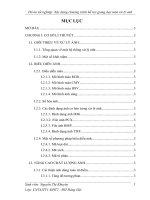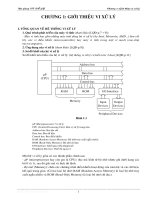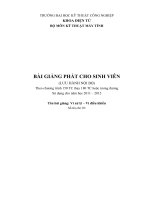Bài giảng môn xử lý ảnh
Bạn đang xem bản rút gọn của tài liệu. Xem và tải ngay bản đầy đủ của tài liệu tại đây (2.82 MB, 106 trang )
Image Compression
Instructor
LE Thanh Sach, Ph.D.
/>
Outline
Introduction
Lossless Compression
Lossy Compression
Introduction
The goal of image compression is to reduce
the amount of data required to represent a
digital image.
Important for reducing storage
requirements and improving transmission
rates.
Approaches
Lossless
Information preserving
Low compression ratios
e.g., Huffman
Lossy
Does not preserve information
High compression ratios
e.g., JPEG
Tradeoff: image quality vs compression ratio
Data vs Information
Data and information are not synonymous terms!
Data is the means by which information is
conveyed.
Data compression aims to reduce the amount of
data required to represent a given quantity of
information while preserving as much information
as possible.
Data Redundancy
Data redundancy is a mathematically
quantifiable entity!
compression
Data Redundancy (cont’d)
Compression ratio:
Relative data redundancy:
Example:
Types of Data Redundancy
(1) Coding
(2) Interpixel
(3) Psychovisual
The role of compression is to reduce one or
more of these redundancy types.
Coding Redundancy
Data compression can be achieved using an
appropriate encoding scheme.
Example: binary encoding
Encoding Schemes
Elements of an encoding scheme:
Code: a list of symbols (letters, numbers,
bits etc.)
Code word: a sequence of symbols used to
represent a piece of information or an event
(e.g., gray levels)
Code word length: number of symbols in
each code word
Definitions
N x M image
rk: k-th gray level
P(rk): probability of rk
Expected value:
E ( X ) = ∑ xP( X = x)
x
Constant Length Coding
l(rk) = c which implies that Lavg=c
Example:
Avoiding Coding Redundancy
To avoid coding redundancy, codes should
be selected according to the probabilities of
the events.
• Variable Length Coding
Assign fewer symbols (bits) to the more
probable events (e.g., gray levels for images)
Variable Length Coding
Consider the probability of the gray levels:
variable length
Interpixel redundancy
Interpixel redundancy implies that any pixel
value can be reasonably predicted by its
neighbors (i.e., correlated).
Interpixel redundancy (cont’d)
To reduce interpixel redundnacy, the data must
be transformed in another format (i.e., through a
transformation)
e.g., thresholding, or differences between adjacent pixels, or
DFT
(profile – line 100)
original
Example:
threshold
thresholded
(1+10)
Interpixel redundancy (cont’d)
To reduce interpixel redundnacy, the data must
be transformed in another format (i.e., through a
transformation)
e.g., thresholding, or differences between adjacent pixels, or
DFT
(profile – line 100)
original
Example:
threshold
thresholded
(1+10)
Psychovisual redundancy
Takes into advantage the peculiarities of the
human visual system.
The eye does not respond with equal
sensitivity to all visual information.
Humans search for important features (e.g.,
edges, texture, etc.) and do not perform
quantitative analysis of every pixel in the
image.
Psychovisual redundancy (cont’d)
Example: Quantization
256 gray levels
16 gray levels
16 gray levels
improved gray-scale quantization
8/4
=
2:1
i.e., add to each pixel a
pseudo-random number
prior to quantization
How do we measure information?
What is the information content of a
message/image?
What is the minimum amount of data that is
sufficient to describe completely an image
without loss of information?
Modeling the Information Generation
Process
Assume that information generation process
is a probabilistic process.
A random event E which occurs with
probability P(E) contains:
How much information does a pixel
contain?
Suppose that the gray level value of pixels
is generated by a random variable, then r k
contains
units of information
Average information of an image
Entropy: the average information content of
L −1
an image
E = ∑ I (rk ) Pr(rk )
k =0
using
we have:
units/pixel
Assumption: statistically independent random events
Modeling the Information Generation Process
(cont’d)
Redundancy:
where:
Entropy Estimation
Not easy!
image









